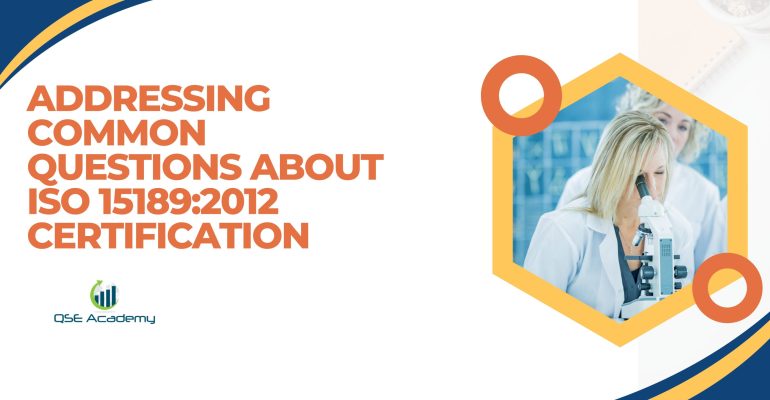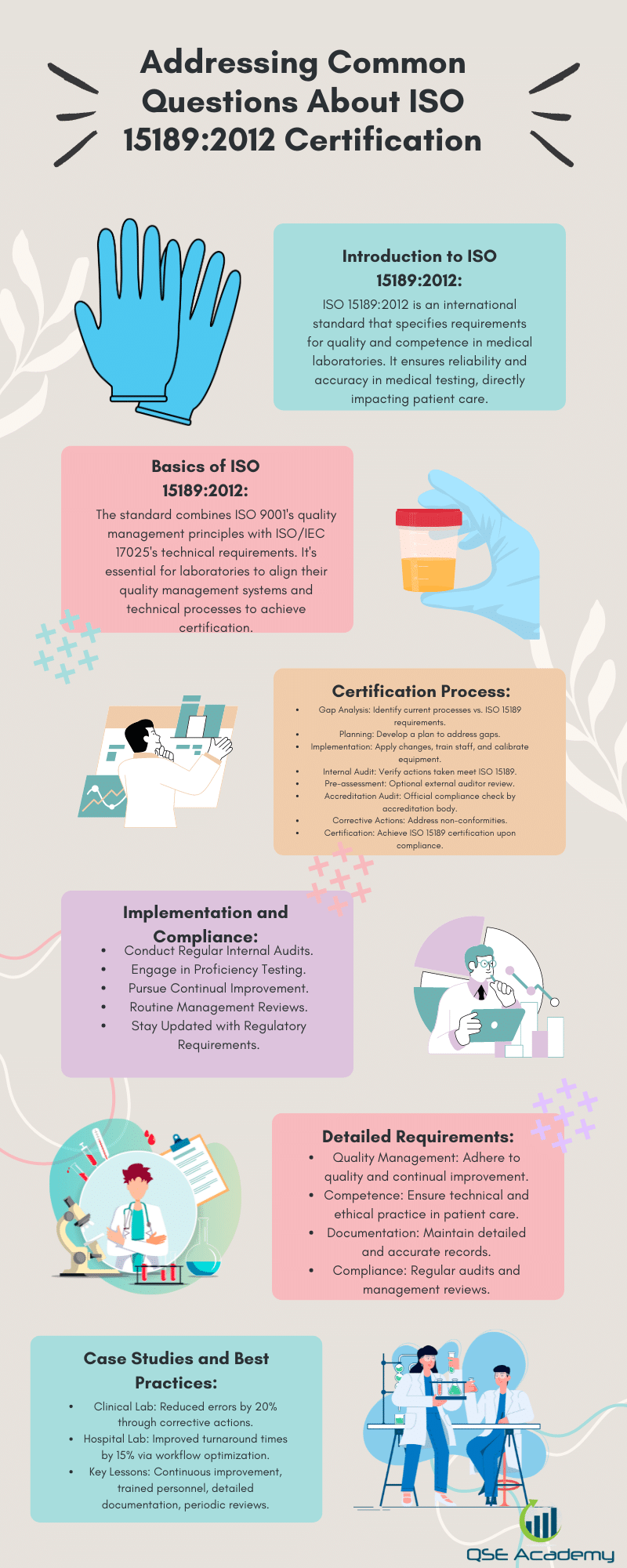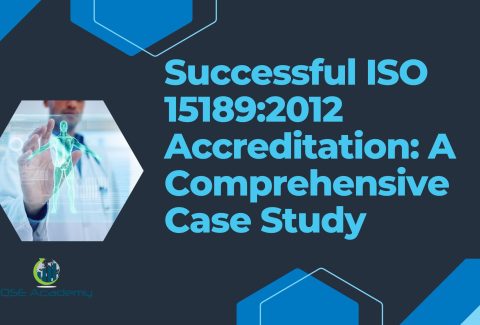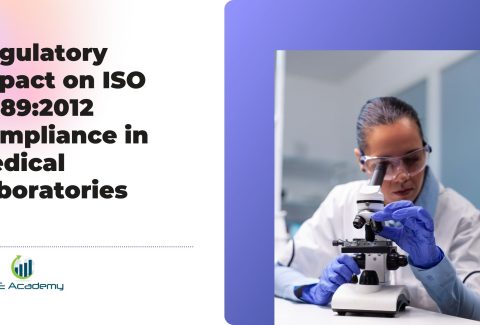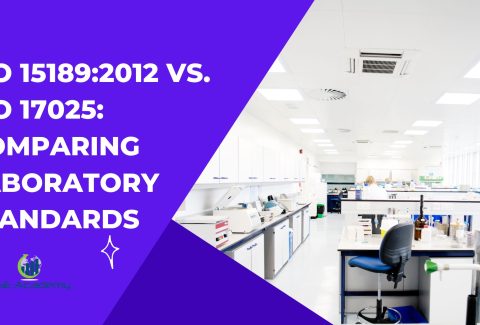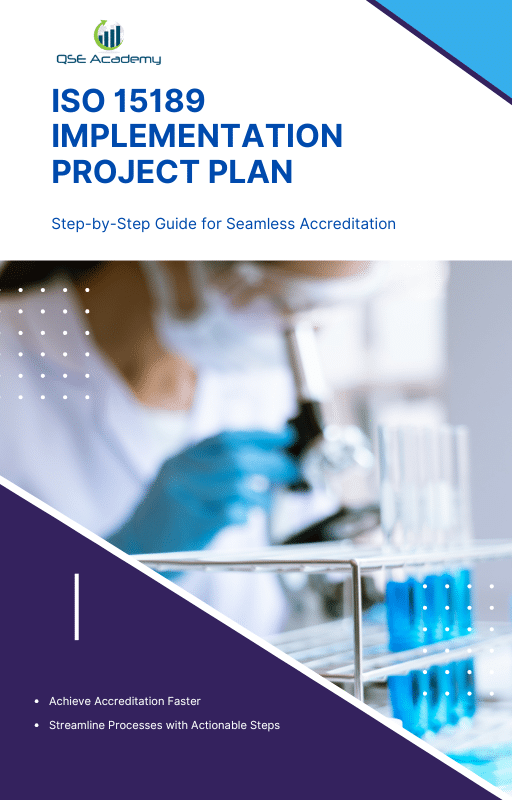Abordando questões comuns sobre a certificação ISO 15189:2012
Navegar no panorama das normas internacionais pode parecer uma viagem através de um labirinto intrincado. A ISO 15189:2012, especificamente, estabelece referências críticas para laboratórios médicos em todo o mundo. Os meandros da obtenção de certificação ao abrigo desta norma podem muitas vezes levar a uma multiplicidade de questões. Este artigo pretende desmistificar os principais aspectos da ISO 15189:2012, descrevendo o processo de certificação e as principais estratégias de implementação, com o objetivo de transformar a confusão em clareza.
Introdução
A ISO 15189:2012 é uma norma internacional que especifica os requisitos de qualidade e competência em laboratórios médicos. Desenvolvida para apoiar os processos complexos envolvidos nos testes médicos, a norma é fundamental para os laboratórios que pretendem garantir a fiabilidade e a precisão dos seus resultados, que têm um impacto direto nos cuidados aos doentes.
A ISO 15189:2012 é vital para os laboratórios, uma vez que combina os princípios do sistema de gestão da qualidade da ISO 9001 com os requisitos técnicos da ISO/IEC 17025, específicos para ambientes de testes médicos. A certificação garante aos pacientes, prestadores de cuidados de saúde e organismos reguladores que um laboratório cumpre as normas de qualidade organizacional e os conhecimentos técnicos necessários para a realização de ensaios médicos.
O percurso da ISO 15189 começou no início dos anos 2000, surgindo da necessidade de harmonizar as práticas laboratoriais a nível global. Desde a sua criação, tem sido actualizada para abranger as melhores práticas em evolução e os avanços tecnológicos na medicina laboratorial.
|
Requisito |
Descrição |
|---|---|
|
Qualidade |
Adesão a sistemas de gestão da qualidade e estratégias de melhoria contínua. |
|
Competência |
Competência técnica e prática ética no manuseamento de amostras de doentes e na elaboração de relatórios. |
Os laboratórios médicos que obtêm a certificação ISO 15189:2012 demonstraram o seu empenho em fornecer serviços de qualidade, manter o equipamento de laboratório e garantir a competência dos seus testes - todos eles essenciais para um excelente tratamento dos doentes.
Noções básicas da norma ISO 15189:2012
O que é a ISO 15189:2012?
A ISO 15189:2012 é uma norma internacional que especifica os requisitos de qualidade e competência em laboratórios médicos. Foi concebida para promover a utilização de serviços laboratoriais fiáveis que são essenciais para a prestação de cuidados de elevada qualidade aos doentes.
Explicação da norma ISO 15189:2012
A norma engloba um sistema de gestão da qualidade abrangente, abordando factores como a calibração de equipamento de laboratório, o manuseamento de amostras e a prática ética. Alinha-se com os princípios gerais da norma ISO 9001 e está harmonizada com a norma ISO/IEC 17025, que se aplica a laboratórios de calibração e de ensaio.
Âmbito e objetivo da norma
O âmbito da ISO 15189:2012 está centrado na melhoria dos serviços de qualidade prestados pelos laboratórios médicos através de uma abordagem de melhoria contínua. O seu objetivo é estabelecer critérios que garantam a competência dos testes, a eficácia dos processos operacionais e a fiabilidade dos resultados laboratoriais. Isto é fundamental para a realização de testes e diagnósticos médicos exactos, apoiando assim melhores resultados nos cuidados aos doentes.
Processo de certificação
A obtenção da certificação ISO 15189:2012 exige que os laboratórios clínicos e médicos sejam submetidos a um processo metódico para demonstrar a conformidade com a norma. Este processo consiste normalmente em várias etapas destinadas a garantir serviços de qualidade e competência técnica em testes médicos. Segue-se uma descrição geral do processo de certificação:
- Análise de lacunass: Os laboratórios realizam uma análise interna para identificar quaisquer diferenças entre os seus processos actuais e os requisitos da norma ISO 15189.
- Planeamento: Desenvolvimento de um plano de projeto para resolver as lacunas e alinhar os sistemas de gestão da qualidade do laboratório com os requisitos da norma.
- Implementação: Os laboratórios aplicam alterações nos seus processos, incluindo a atualização de procedimentos, a formação de pessoal e a garantia de que o equipamento de laboratório é calibrado de acordo com os requisitos regulamentares.
- Auditoria Interna: Após a implementação das alterações, é realizada uma auditoria interna para verificar se as medidas tomadas satisfazem efetivamente os critérios da norma ISO 15189:2012.
- Pré-avaliação: Uma etapa opcional em que um auditor externo avalia o grau de preparação do laboratório para o processo de acreditação oficial.
- Auditoria de acreditação: Efectuada por um organismo de acreditação, a auditoria avalia a conformidade do laboratório através da análise da documentação, das práticas e da competência do pessoal.
- Acção Correctivas: Se forem identificadas não-conformidades, o laboratório deve tomar medidas corretivas antes da aprovação final.
- Certificação: Quando a conformidade é confirmada, o laboratório recebe a certificação ISO 15189:2012, assinalando a sua dedicação à melhoria contínua dos cuidados prestados aos pacientes e à gestão da qualidade.
Aplicação e conformidade
A implementação da norma ISO 15189:2012 num laboratório médico está centrada no estabelecimento, gestão e manutenção de um Sistema de Gestão da Qualidade (SGQ) que cumpra as normas internacionais de qualidade e competência. Para manter a conformidade com a ISO 15189:2012, os laboratórios devem:
- Realizar auditorias internas regulares:
- Avaliar os processos em função dos requisitos da norma.
- Identificar áreas a melhorar.
- Envolver-se em testes de proficiência:
- Demonstrar competência técnica na realização de ensaios.
- Validar a exatidão e a fiabilidade dos resultados.
- Perseguir Melhoria contínua:
- Aplicar acções corretivas e preventivas, se necessário.
- Atualizar as políticas e os protocolos para os adaptar à evolução das tecnologias e das práticas.
- Análises de gestão de rotina:
- Assegurar o cumprimento dos objectivos de qualidade.
- Fomentar o empenhamento da liderança no SGQ.
- Mantenha-se atualizado com Exigências regulamentaress:
- Alinhar as práticas laboratoriais com as alterações legislativas e regulamentares.
- Assegurar que os cuidados prestados aos doentes não são comprometidos por incumprimento.
A manutenção da certificação exige que os laboratórios não só mantenham as normas inicialmente cumpridas para a acreditação, mas também demonstrem a aplicação contínua do SGQ através de práticas éticas, formação do pessoal e empenho na prestação de serviços de qualidade. Os organismos de acreditação efectuam auditorias de controlo periódicas para verificar a conformidade contínua com a norma. Este ciclo de avaliação, juntamente com a dedicação de um laboratório à Melhoria Contínua, garante a realização consistente de testes médicos precisos e apoia o objetivo global de melhorar os cuidados prestados aos doentes.
Requisitos pormenorizados
A certificação ISO 15189:2012 inclui requisitos abrangentes que garantem que os laboratórios médicos cumprem normas elevadas de qualidade e competência. As questões legais e contratuais exigem que os laboratórios cumpram os requisitos regulamentares e as práticas éticas relevantes para as suas actividades. Isto inclui a manutenção da imparcialidade e da estrita confidencialidade relativamente às informações dos doentes e aos resultados dos testes.
Estruturalmente, um laboratório conforme deve ter uma estrutura organizacional bem definida com responsabilidades claras de gestão. O pessoal deve ter funções designadas e ser responsável pelas respectivas tarefas, contribuindo para a eficácia dos sistemas de gestão da qualidade.
Em termos de recursos, a norma ISO 15189:2012 realça a competência do pessoal do laboratório. A educação, a formação e o desenvolvimento profissional contínuo adequados são essenciais. Além disso, as instalações e infra-estruturas devem apoiar o desempenho preciso e fiável dos testes médicos.
Os processos também são escrutinados, desde as fases pré-exame até ao pós-exame. Espera-se que os laboratórios médicos tenham procedimentos documentados que garantam a qualidade dos cuidados prestados aos doentes. Isto inclui a recolha, manuseamento e análise adequados de amostras de doentes e práticas de manutenção de registos seguras e precisas.
Finalmente, a norma exige um sistema de gestão robusto que é revisto regularmente através de auditorias internas e análises de gestão, promovendo uma cultura de melhoria contínua. As acções preventivas e corretivas são partes integrantes do programa de acreditação de laboratórios para resolver quaisquer lacunas identificadas na qualidade do serviço ou na gestão do laboratório.
Cenários específicos e estudos de caso
ISO 15189:2012 Em todos os sectores:
A norma ISO 15189:2012 é predominantemente aplicável a laboratórios médicos e foi concebida para melhorar a sua qualidade e competência. Embora esta norma internacional tenha as suas raízes firmemente nos cuidados aos doentes, incorpora elementos da norma ISO/IEC 17025, que rege os laboratórios de calibração. Por conseguinte, qualquer laboratório que efectue ensaios médicos ou esteja envolvido nos cuidados aos doentes - desde ambientes clínicos a ambientes de ensaio de cuidados - pode beneficiar da sua implementação.
Modificações por sector:
Para as indústrias não médicas, a estrutura ISO 15189 inspira a adoção de sistemas rigorosos de gestão da qualidade, práticas éticas e melhoria contínua. No entanto, os requisitos de qualidade, especificamente na gestão e no trabalho técnico, devem ser contextualizados para os requisitos regulamentares específicos da indústria.
Histórias de sucesso:
- Um pequeno laboratório clínico registou uma redução de 20% nos erros após a implementação dos processos de ação corretiva e preventiva da norma ISO 15089:2012.
- Um laboratório de um hospital regional melhorou os seus tempos de execução em 15% através da otimização do fluxo de trabalho inspirada na análise de lacunas durante o processo de acreditação.
Melhores práticas adoptadas:
- Envolver-se na melhoria contínua e em auditorias internas regulares.
- Assegurar que todo o pessoal do laboratório está bem informado sobre os requisitos técnicos específicos.
- Manutenção de documentação pormenorizada para todos os processos, de acordo com os requisitos da norma ISO 15189:2012.
- Utilização de organismos de acreditação para revisões periódicas e validação da competência técnica.
Estes cenários demonstram o valor da norma ISO 15189:2012 na promoção de serviços de qualidade em laboratórios médicos e na garantia de cuidados fiáveis aos doentes.
Recursos adicionais
Ao procurar recursos oficiais sobre a ISO 15189:2012, as partes interessadas devem começar pelo site da International Organization for Standardization (ISO), que fornece detalhes abrangentes sobre a norma. Além disso, os organismos de acreditação nacionais oficiais que são membros da International Laboratory Accreditation Cooperation (ILAC) podem fornecer informações relevantes. As associações profissionais para laboratórios médicos e sistemas de gestão da qualidade podem oferecer literatura e diretrizes adequadas ao ambiente do laboratório clínico.
Os recursos recomendados incluem:
- Sítio Web da ISO: www.iso.org
- Sítio Web da ILAC: www.ilac.org
- Organismos nacionais de acreditação: Os sítios Web variam consoante o país
Associações e organizações profissionais:
- Instituto de Normas Clínicas e Laboratoriais (CLSI)
- IFCC (Federação Internacional de Química Clínica e Medicina Laboratorial)
Para quem procura formação sobre a norma ISO 15189:2012, vários fornecedores oferecem cursos que vão desde a compreensão básica até aos sistemas avançados de gestão da qualidade e formação de auditor líder. A importância desta formação não pode ser subestimada, uma vez que orienta os laboratórios através das nuances da implementação que, em última análise, servem os cuidados ao paciente e a competência do laboratório.
Programas de formação podem incluir:
- ISO 15189:2012 Cursos de Introdução
- Formação em sistemas de gestão da qualidade
- Certificação de Auditor Líder para Laboratórios Médicos
Estes programas de formação podem ser encontrados através de:
- Sítio Web ISO e suas filiais
- Organismos de acreditação e respectivos prestadores de formação aprovados
Para simplificar a conformidade com a norma ISO 15189:2012, os laboratórios podem utilizar várias ferramentas e modelos. Estes incluem frequentemente listas de verificação de análise de lacunas, procedimentos operacionais normalizados e modelos de controlo de documentos. A utilização eficaz destas ferramentas implica a sua adaptação aos processos e fluxos de trabalho específicos do laboratório. A melhoria contínua e a adesão aos requisitos da norma ISO 15189:2012 podem ser grandemente facilitadas por estes recursos.
Ferramentas e modelos eficazes:
- Listas de verificação de análise de lacunas
- Modelos de SOP
- Modelos de controlo de documentos
- Planos de ação corretivos e preventivos
Estes podem ser obtidos a partir de:
- Organismos de acreditação e consultores ISO
- Mercados em linha especializados em recursos ISO
- Organizações profissionais de laboratórios
Consulte as tabelas e listas fornecidas para obter uma visão geral estruturada destes recursos, assegurando um acesso e uma referência fáceis para os laboratórios médicos no seu percurso para obter e manter a certificação ISO 15189:2012.
Conclusão
Compreender e aderir à norma ISO 15189:2012 é crucial para que os laboratórios médicos garantam a prestação de serviços de qualidade, melhorem os cuidados prestados aos doentes e mantenham a competência técnica. Esta norma internacional define os requisitos de qualidade e competência em laboratórios médicos, salientando a necessidade de sistemas de gestão da qualidade rigorosos, práticas éticas e melhoria contínua. Através do processo de acreditação, os laboratórios demonstram a sua capacidade de funcionar de acordo com os requisitos regulamentares e especificações técnicas estabelecidos, promovendo a confiança nos testes médicos.
Ao olharmos para o futuro, a tendência vai no sentido de uma precisão ainda maior na gestão laboratorial, com uma mudança de foco para a melhoria contínua e acções preventivas. O alinhamento da ISO 15189:2012 com normas relacionadas, como a ISO/IEC 17025, atesta a abordagem integrada dos programas de acreditação de laboratórios. Os laboratórios que pretendem manter-se na vanguarda devem realizar análises regulares das lacunas e implementar acções corretivas para colmatar quaisquer disparidades com os requisitos da ISO 15189, indicando um compromisso contínuo com a excelência nos cuidados aos doentes e nos serviços de qualidade.
O cenário em evolução da acreditação de laboratórios médicos prevê uma ênfase crescente na melhoria da segurança e dos cuidados prestados aos doentes através de avanços tecnológicos e de uma adesão mais rigorosa aos padrões de referência internacionais definidos pelas normas ISO.
Referências
Para uma compreensão e implementação pormenorizadas da norma ISO 15189:2012, que é essencial para os laboratórios médicos que pretendem demonstrar a fiabilidade das suas operações e o seu compromisso com os cuidados prestados aos doentes, os recursos que se seguem fornecem orientações autorizadas:
- ISO 15189:2012 Laboratórios médicos - Requisitos de qualidade e competência: O próprio documento da Organização Internacional de Normalização (ISO) é a principal referência para qualquer laboratório que pretenda obter acreditação.
- ISO/IEC 170252017 Requisitos gerais para a competência dos ensaios e laboratórios de calibração: Embora específica para laboratórios de calibração, esta norma partilha muitos princípios com a ISO 15189 e é relevante para a compreensão dos requisitos de competência laboratorial.
- Instituto de Normas Clínicas e Laboratoriais (CLSI): Oferece uma coleção de melhores práticas e normas para laboratórios clínicos.
- Organização Mundial de Saúde (OMS): Fornece várias publicações relacionadas com a gestão da qualidade em laboratórios médicos que podem ser alinhadas com os princípios da ISO 15189.
- Os sítios Web dos organismos de acreditação nacionais e regionais oferecem orientações específicas, interpretações e listas de verificação adaptadas ao seu processo de acreditação.
Os recursos listados são essenciais para complementar os programas de acreditação de laboratórios, facilitando a compreensão da norma ISO por parte dos laboratórios e promovendo a melhoria contínua das operações laboratoriais e dos cuidados prestados aos doentes. Actas de conferências e artigos académicos sobre gestão laboratorial, práticas éticas e competência técnica contribuem ainda mais para uma compreensão aprofundada dos requisitos de certificação.
Apêndice
Glossário de termos-chave
- Laboratórios médicos: Instalações que efectuam análises clínicas em amostras de pacientes para ajudar no diagnóstico, tratamento e prevenção de doenças.
- Requisitos de qualidade: Critérios delineados para garantir que os laboratórios médicos funcionam com práticas de elevada qualidade, conduzindo a resultados de testes fiáveis.
- Norma internacional: Um conjunto de diretrizes globalmente reconhecido que especifica como as organizações devem ser concebidas, geridas e operadas.
- ISO/IEC 17025: Uma norma para laboratórios de calibração e ensaio, abrangendo sistemas de gestão da qualidade, competência técnica e capacidade de produzir dados de ensaio e calibração precisos e exatos.
- Cuidados com o paciente: Serviços e práticas que estão diretamente envolvidos na prestação de ajuda sanitária aos indivíduos.
- Sistema de Gestão de Qualidades: Um conjunto de políticas, processos e procedimentos necessários para o planeamento e execução na área de negócio principal de uma organização.
- Laboratórios clínicos: Laboratórios que efectuam análises de diagnóstico químico, hematológico, imunológico, microscópico e bacteriológico em fluidos corporais, como o sangue e a urina.
- Exigências regulamentaress: Condições obrigatórias estabelecidas pelas autoridades que as organizações devem cumprir para funcionar legalmente.
- Requisitos técnicoss: Regras e critérios técnicos específicos que uma instalação ou um produto deve respeitar, frequentemente para garantir a segurança e a eficácia.
- Competência dos ensaios: A capacidade comprovada de um laboratório para efetuar ensaios e calibrações de forma precisa e fiável.
- Melhoramento Contínuo: Um esforço contínuo para melhorar produtos, serviços ou processos para aumentar a qualidade e o desempenho.
- Equipamento de laboratório: Ferramentas e dispositivos utilizados por cientistas em laboratórios para análise ou investigação científica.
O apêndice de um documento relacionado com a norma ISO 15189:2012 inclui normalmente informações suplementares que apoiam o conteúdo principal do documento. Pode consistir em procedimentos pormenorizados, notas explicativas, dados adicionais e referências essenciais para uma compreensão abrangente, mas não necessariamente dentro do corpo principal do texto. O apêndice é útil para fornecer material aprofundado sem complicar demasiado o fluxo da secção principal do documento.
No caso dos documentos da norma ISO 15189:2012, os apêndices podem incluir:
- Modelos ou exemplos de documentos utilizados nos sistemas de gestão da qualidade.
- Listas de controlo para auditorias internas ou análises de lacunas.
- Guias pormenorizados para cumprir os requisitos técnicos.
- Informações sobre os processos de melhoria contínua ou permanente.
- Recursos para compreender as práticas regulamentares ou éticas específicas dos testes médicos em laboratórios clínicos.
A inclusão de um apêndice oferece ao leitor recursos adicionais para obter uma compreensão clara dos requisitos e aplicações práticas da norma ISO 15189:2012.
Procurando por mais recursos sobre a ISO 15189?
Se este artigo foi útil para si, explore os nossos recursos premium concebidos para o ajudar a obter a certificação ISO 17025 de forma eficiente:
- 📦 Pacote de documentação completo para a norma ISO/IEC 15189 2022: Obtenha todos os modelos e documentos essenciais de que necessita para uma implementação rápida e fácil.
- 🎓 Curso online sobre a ISO/IEC 15189 2022 : Inscreva-se na nossa formação abrangente para dominar os conceitos-chave e os passos práticos para a certificação.
- 📋 Lista de verificação ISO/IEC 15189 2022: Descarregue a nossa lista de verificação pormenorizada para se certificar de que abrangeu todas as etapas do processo.
Estes recursos são adaptados para satisfazer as suas necessidades e garantir um percurso de certificação sem problemas. Explore-os hoje e fique um passo mais perto do sucesso!

